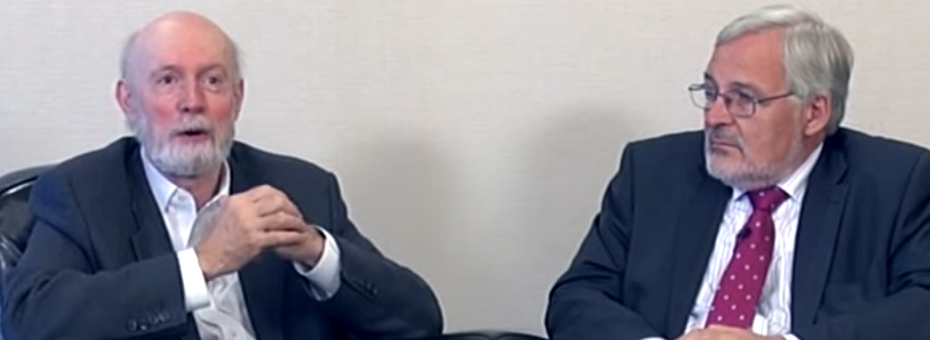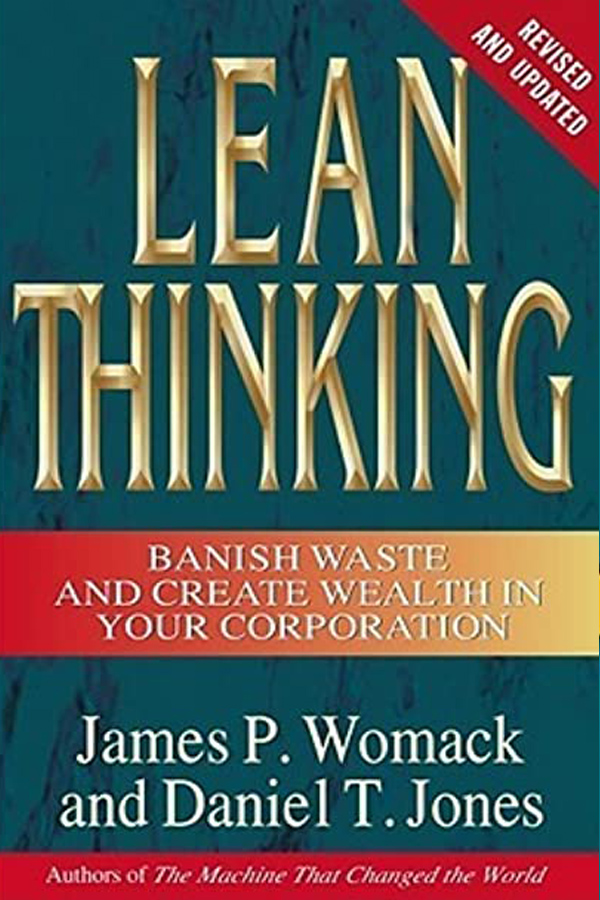Twenty years ago Jim Womack and Dan Jones helped launch the lean movement as we know it today with their key book Lean Thinking. Yesterday we shared some thoughts on the book’s message; and now we have the opportunity to ask the two authors to reflect on how lean thinking and lean practice have evolved since the book appeared. LEI senior editor Tom Ehrenfeld has asked Jim and Dan for their thoughts on a range of topics; please feel free to add your thoughts, comments, and questions over the next two days.
Q: What is the problem that Lean Thinking addresses for today’s reader?
Jim Womack: Twenty years have elapsed since the publication of Lean Thinking, but I don’t see the “problem” as changing very much. Post the Great Recession we have the Great Stagnation, in which organizations struggle to make good margins, customers report declining confidence in the ability of providers to solve their problems, and employees report low engagement and a lack of satisfaction in their work. In other words, what we are facing is not very different from the post-Cold War world of 1996…except that now there seems to be reduced expectations that anything can be improved. Lean thinking was and is the best-known way to sustainably improve this situation.
Dan Jones: The core message remains the same: that there is a better way of doing considerably more with less for those who seek it or need it, whether they are struggling to compete in a changing global economy, delivering more public services like healthcare from limited tax revenues or coping with the consequences of climate change and sustainability. Lean is not a better blueprint or a better theory, but a proven path of learning to work together more effectively. And twenty years later we know that this works in any kind of activity.
Q: What did organizations “get right” about the book?
Jim: The most fundamental insight in Lean Thinking is that organizations need to focus on creating value for customers by working backwards to create an end-to-end value stream for each product family that maximize customer value by minimizing waste. That means creating flow conditions when possible, pull mechanisms when it’s not, and endlessly striving for perfection. (Note that I try not to use the term “companies” because this restricts the focus to for-profit organizations at a given level of the value stream – retailer, distributor, manufacturer, supplier, etc. – when non-profits like health care and governments are now significantly involved and organizations need to think both up-stream and down-stream as they apply lean thinking.)
Most folks got the fundamental point of focusing on the value stream. But what most organizations (and consultants even more so) have not gotten right is the need to create a complete management system that supports these improved value streams. They stop with applying technical tools to achieve rapid improvements and forget (or just don’t have the energy) to tackle the organizational context of value creation both within their firm and between all the firms touching a value stream. The latter issue, of course, is the hard part.
Dan: Lean Thinking was an important step in our long journey to understand the deeper significance of lean practice; and the resulting lean movement is the platform that allows us to conduct many different experiments to distinguish what works from what does not. We quickly realized that tools and value stream maps were not enough without a daily management system, and that would not survive without the active engagement of top management. Hence the search for a way to articulate the business case for lean and the learning process for “managing from the ground up.”
Perhaps the biggest lesson is that there is much more to lean than they (and we) thought, and that adding a bit of lean to existing structures does not last. Lean was recognized as strategic and led from the top in all the cases we described in Lean Thinking, yet this message was largely ignored.
Q: How is Lean Thinking continuing to spread today? Or, what is the future of yokoten?
Dan: We have learned through experience and observation that lean works everywhere—we have seen it introduced in activities as varied as constructing a new building, diagnosing and treating patients and running a school. In sectors like healthcare there is an active worldwide movement led by clinicians exploring different ways of improving care processes. Likewise in city, state and national government.
So we planted lots of seeds and have done what we can to tend and water the resulting shoots. But these ideas will take a long time to grow and there will be many more setbacks along the way. The unique power of these practices is that they can’t be dismissed as not working – they are alive and working in our continuing reference model Toyota. If we struggle we can go back, ask why and unpeel the next layer of the onion.
Jim: I think it’s fair to say that lean thinking, at least as a set of techniques, has now been tried in at least one instance in almost every human activity in every region of the world. (E.g., the recent experiments with “lean farming.”) So there are no more frontiers in that sense. But the creation of true lean enterprises combining lean techniques with lean management has hardly been achieved anywhere. We are still at the beginning of the lean transformation!
The role of the Lean Global Network in this situation is very simple: to urge organizations to strive for complete lean enterprises and not just lean techniques, to give them the coaching to succeed, and to publicize their successes. I’ve said since Lean Thinking was launched with the thought that its most important contribution would be to give managers the courage to try their own experiments. And I hope that continues to be true.
The final point on the spread of lean thinking is that in the future we need to apply it to “big problems” rather than the little problems most folks focus on. For example, the fundamental unit of value in our old friend the auto industry is now shifting from providing the customer with a good car (a significant but “little” problem”) to solving the customer’s mobility problem (a truly big problem) with all sort of innovations involving autonomy, alternative energy, shared assets, etc. The Lean Community needs to be thinking about these big problems and helping create the new types of organizations needed to solve them using lean principles from the beginning.
Q: What have we learned about corporate culture and its impact on lean?
Jim: In Lean Thinking we consciously skipped the whole “corporate culture” debate, which was usually a way for managers to avoid the need to try experiments (“We would like to try lean but our culture doesn’t support it.”). Our position was that if an organization is willing to try experiments in creating smooth-flowing value streams with greatly reduced waste, then the cultural conflicts, if any, will emerge and can become issues for hoshin planning. By contrast, if organizations work on their culture in some abstract way that doesn’t involve actually trying experiments and seeing what the underlying problems are, nothing will be gained.
Dan: In my experience corporate culture is built up from demonstrated behaviors, particularly by leaders, conducting many different experiments across the organization, and from teams sharing stories about defining specific problems, their experiences in solving them, as well as sharing the results and what they learned. I have seen firsthand how stories from the shop floor can change the language and expectations of an organization. In the end, lean changes the relationship people have with their work and indeed the relationship with their customers.
Q: Was the “people dimension” shortchanged in Lean Thinking?
Jim: The book was written at a time when many organizations had tried and failed with “empowerment” programs. A better path ahead seemed to be to focus on the customer (rather than the employees or the owners) and work backwards to create more value with less waste. Trying to do this would then raise all sorts of issues about improving work experience and management practices that could be the subject of additional kaizen activities.
The two points we did make – and that many lean adopters in senior management have ignored – are 1) that lean is not about cost-cutting but about providing more value by means of a better value-creating process and 2) that the work experience will improve when everyone can see the whole value stream and the consequences of their own efforts and get feedback continuously and instantly on how to improve the results while making work easier.
The background to lean implementation in 2016, compared with 1996 is that there is a new wave of anxiety about the disappearance of work through leaps in automation and communication. Thus many think that lean must be about job reduction, that it must be “anti-people.” The problem with this view is that it takes human needs and wants as fixed: if effort is eliminated in one value stream this means a net loss of jobs available in the whole economy. But simple reflection shows that many of our wants – how about a stable climate or a personal touch in the healthcare provided in our declining years? – seem so expensive that we can’t afford them. But what if we convert the waste in our current activities to providing new types of value instead? This is a matter of macroeconomics and society’s will to apply freed-up resources in new ways, not a problem with lean.
Dan: I am always cautious when people ask about the people dimension to lean, when what they are really asking is how to engage and motivate people in a traditional system focused on compliance with systems designed by experts. It was always obvious to me that you could not run a complicated, multi-stage value stream from which the buffers and safety nets have been removed without the active engagement of the front line. So this would inevitably lead to a reversal of the separation between the experts and the doers. In a very real sense, a value stream is the sum of the capabilities of the people involved in running it. This only works when there is real respect for challenging and developing the capabilities of every employee.
While Taiichi Ohno based his learning-by-doing process on the pioneering TWI program, he went further and developed his Toyota Production System as a framework for helping employees to learn how to improve their work. The elements of TPS are intrinsically linked in a way that makes a customer-driven process flow possible. Deeper experience with TPS is the key to engaging people and providing meaningful direction to their work.
Q: What does lean tell us about the disappearance of work?
Jim: See the answer above. The one dimension to add is that much of the anxiety today about the disappearance of work involves middle-class professional work, which was previously thought to be beyond the reach of automation and autonomy. Even doctors are starting to worry about Dr. Watson! The lean stance, I believe, is that there will always be plenty of things for humans to do that rely on our humanness: empathy and outreach to others to put ourselves in their place and try to solve their life problems. And…these activities will still be processes that are subject to continual improvement!
Dan: This is a symptom of a much deeper divide between those who seek “people-free” versus “people-centric” solutions. You can see it in the current debates about autonomous, driverless cars, as opposed to using technology to help drivers make better decisions. But you can also see it in management, where the prevailing logic relies on experts to design systems and processes which anyone can operate, while management focuses on compliance and optimization. Lean is explicitly a “people-centric” approach engaging front-line teams and support staff in understanding and continuously improving their work, yielding dynamic economies and lessons to improve the next generation product or service. My hunch is that “people-centric” solutions are cheaper to start, cheaper to maintain, more exactly focused on the varied needs of users and waste far less resources, while at the same time they can easily adapt to changing circumstances. Lean provides an alternative voice to the relentless march of those seeking “people-free” solutions.
Join us again tomorrow for Part 2 of this Q&A with the authors of Lean Thinking.








